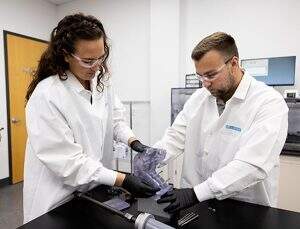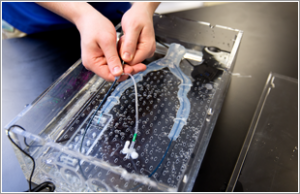Physiologic Model Development
Engineering Services
 Anatomic and physiologic modeling plays an important role in understanding human anatomy and disease and ultimately how a device performs in worst-case patient populations. Researching literature and working with physicians provide important inputs to developing an appropriate model. Each patient is unique and so are the diseases and disease states that result in morphologic changes within the body. Developing a model for a diverse patient population that will be used for design verification testing is a significant challenge. Developing a model that can represent a global device rollout may require multiple models to fully address the breadth of clinical scenarios. We have created physiologic models that mimic the clinical environment by leveraging cadaveric models, experience of physicians, as well as other resources. Understanding how to navigate these valuable resources is a great experience to share with our clients. Using these inputs combined with our experience have helped us create unique clinically relevant models and their associated justifications to evaluate device safety for many clients.
Anatomic and physiologic modeling plays an important role in understanding human anatomy and disease and ultimately how a device performs in worst-case patient populations. Researching literature and working with physicians provide important inputs to developing an appropriate model. Each patient is unique and so are the diseases and disease states that result in morphologic changes within the body. Developing a model for a diverse patient population that will be used for design verification testing is a significant challenge. Developing a model that can represent a global device rollout may require multiple models to fully address the breadth of clinical scenarios. We have created physiologic models that mimic the clinical environment by leveraging cadaveric models, experience of physicians, as well as other resources. Understanding how to navigate these valuable resources is a great experience to share with our clients. Using these inputs combined with our experience have helped us create unique clinically relevant models and their associated justifications to evaluate device safety for many clients.
 The next step after conceptualizing the anatomic model is to fabricate the model. Pictured is one of our training models used for physician training on a global scale following regulatory approval to market and prior to commercial launch. Other models we have developed represent the pulsatility of a vein or artery, while yet others represent drug release and capture specific design elements. Ultimately, you want your model to be anatomically representative, but also as close to replicating the physiologic setting as possible. We currently offer a full set of material and material derivatives for use with our client’s devices.
The next step after conceptualizing the anatomic model is to fabricate the model. Pictured is one of our training models used for physician training on a global scale following regulatory approval to market and prior to commercial launch. Other models we have developed represent the pulsatility of a vein or artery, while yet others represent drug release and capture specific design elements. Ultimately, you want your model to be anatomically representative, but also as close to replicating the physiologic setting as possible. We currently offer a full set of material and material derivatives for use with our client’s devices.
Key Activities
Model Development, Physiologic Relevance, Tube and Model Creation
OUR COMMITMENT
We are committed to consistently performing services with high quality, that deliver exceptional results, and add value to the client’s business.
For client surveys sent in 2024, we received ratings of 4.98/5 points (13).
